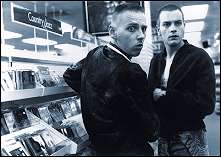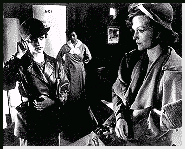|
| |

Contents | Features | Reviews | News | Archives | Store
Bugs in the System (the Dolby Test),
The Winners and Losers ...
The final week of SIFF was marked by
madness on all levels. At the same time that several major films - Lone Star, L'America and The
Umbrellas of Cherbourg - were making their bows to enthusiastic and overflow
audiences, the technical gremlins that had been popping their heads up periodically
throughout the festival chose to come alive in full-blown malevolence.
With temperatures of all sorts already on high at the Egyptian (what
air conditioning?), the Dolby sound system suffered a severe, if temporary, lapse
during the fourth screening, necessitating a half-hour delay and the use of only one
projector to limp through the remainder of the film. Consequently, after those of us lined
up for Trainspotting had fought our way to our seats, we were treated to an
unexpected double bill, with the addition of the Dolby System Test Film to the evening's
fare. A remarkable cinematic document, replete with several high-frequency sound tests
designed to set your teeth on edge, unique graphics and its use of all manner of
fascinating terminology (define 'azimuth'), the film had three run-throughs, to increasing
applause and audience participation. One
individual was sufficiently moved by the spectacle to wave his Bic lighter back and
forth in time to some of the sound effects. Maybe it was the specter of too many films in
too many weeks, but I was on the verge of believing that it was the best thing I'd seen
that week. Reality returned when an embarrassed Darryl sternly informed us that we could
not give the Golden Space Needle Award to the test film, regardless of how we felt about
it. It was a measure of how far gone many of us were when our response was to boo and hiss
at him. Hopefully, all of this sibilant banter was in good fun, but, because of the
forty-five-minute delay in starting Trainspotting, Darryl was probably fortunate
that no one had any leftover fruit in his or her backpack...
 But, in terms of filmmaking power, not even
the gremlins could thwart the effect that Trainspotting had on its initial
Seattle audience. If the reception accorded the film at this year's SIFF was any
indication of future success stateside, then it is in for a very good time, both
critically and commercially. On closing night, just before the U.S. première of Robert
Altman's latest, Kansas City, it was announced that Trainspotting had
won the Golden Space Needle Award for Best Picture, and Boyle had won in the Best Director
category, a phenomenal success given the fact that the first screening of Trainspotting
concluded only half an hour before balloting for the awards closed. Perhaps the first clue
to the film's eventual success should have been evinced by ticket sales alone; both
screenings were completely sold out two weeks in advance. But, in terms of filmmaking power, not even
the gremlins could thwart the effect that Trainspotting had on its initial
Seattle audience. If the reception accorded the film at this year's SIFF was any
indication of future success stateside, then it is in for a very good time, both
critically and commercially. On closing night, just before the U.S. première of Robert
Altman's latest, Kansas City, it was announced that Trainspotting had
won the Golden Space Needle Award for Best Picture, and Boyle had won in the Best Director
category, a phenomenal success given the fact that the first screening of Trainspotting
concluded only half an hour before balloting for the awards closed. Perhaps the first clue
to the film's eventual success should have been evinced by ticket sales alone; both
screenings were completely sold out two weeks in advance.
Other Golden Space Needle winners included Lili Taylor for Best Actress
(for her performances in I Shot
Andy Warhol, Girlstown and Cold Fever - she also, if I'm not
mistaken, contributed a beautifully-measured cameo to Tim Metcalfe's Killer: Journal of a Murder);
Hype! was the winner in the Best Documentary
category; and Vincent D'Onofrio won the Best Actor award for his work in the opening-night
film, The Whole Wide World.
That film also picked up an Independent Film award for its director, Dan Ireland.
Sound glitches also plagued Altman's new film, Kansas City, but,
unfortunately, the technical difficulties were only the least of its problems. Altman is
one of those problematic directors, whose work suffers from what might politely be
referred to as inconsistency in execution. When Altman's work is brilliant and insightful,
it is all that and more, but experience states that, for every M*A*S*H or Nashville,
there is always a Health waiting just over the horizon to trap the unwary
filmgoer.
 Unfortunately, Kansas City falls into that other, more regrettable
category: 'Films by Altman To Be Avoided At All Costs'. KC was one of the most anemic
offerings in the festival, despite the presence of modern jazz greats, such as Joshua
Redmond, standing in for their illustrious predecessors. Everything was wrong with it,
from pacing that borrowed its inspiration from overcooked spaghetti, to an uninspired
script, to thoroughly unlikable leads; the lack of chemistry between Miranda Richardson
and Jennifer Jason Leigh permeated every scene they were in together, and those
constituted the majority of the film; consequently, the film's impending and ungraceful
demise was obvious forty minutes into the proceedings. Unfortunately, Kansas City falls into that other, more regrettable
category: 'Films by Altman To Be Avoided At All Costs'. KC was one of the most anemic
offerings in the festival, despite the presence of modern jazz greats, such as Joshua
Redmond, standing in for their illustrious predecessors. Everything was wrong with it,
from pacing that borrowed its inspiration from overcooked spaghetti, to an uninspired
script, to thoroughly unlikable leads; the lack of chemistry between Miranda Richardson
and Jennifer Jason Leigh permeated every scene they were in together, and those
constituted the majority of the film; consequently, the film's impending and ungraceful
demise was obvious forty minutes into the proceedings.
You know a film is bad when the only sign of life from the audience -
and the film - come after a scene in which these accomplished jazz musicians give an
electrifying performance and the audience breaks out into spontaneous applause which
contains more than a hint of desperation. Many people (myself included) found that a
periodic trip to the lobby, or two, or three, made the film bearable - just. Word had it
that Alex Cox's Lust and Revenge had much the same effect on people.
There were brighter notes. Todd
Solondz's second feature, Welcome to the Dollhouse, lived up to its billing as a
Sundance prize winner. A brutally lacerating dark comedy about the stint in hell known as
seventh grade, it follows the torments of one Dawn Wiener (in an on-target performance by
Heather Matarazzo), who, as the middle child in her family, and an ugly duckling at
school, has no respite from suffering in either place. Eventually, Dawn must choose
between her desire to be liked and the need to develop and assert her own identity.
 To describe the film any further would be to reveal too many of the nuances that
provide it with such a rich set of psychological underpinnings, but anyone who does not
feel a sickening jolt of recognition during the opening sequence, when Dawn has to find a
seat in the crowded cafeteria with her lunch tray grasped firmly in her sweaty hands,
either spent his or her adolescence in a cave or was one of those delightful shake-down
artists who should have. I would give Welcome to the Dollhouse unqualified
applause, except for a few qualms, as yet unresolved, about the extent to which the film
may be trying too hard to ingratiate itself into the sensibilities of former social
lepers, and whether said ingratiating tone is synonymous with a filmmaker's condescension.
In other words, is the joke really on the audience? To describe the film any further would be to reveal too many of the nuances that
provide it with such a rich set of psychological underpinnings, but anyone who does not
feel a sickening jolt of recognition during the opening sequence, when Dawn has to find a
seat in the crowded cafeteria with her lunch tray grasped firmly in her sweaty hands,
either spent his or her adolescence in a cave or was one of those delightful shake-down
artists who should have. I would give Welcome to the Dollhouse unqualified
applause, except for a few qualms, as yet unresolved, about the extent to which the film
may be trying too hard to ingratiate itself into the sensibilities of former social
lepers, and whether said ingratiating tone is synonymous with a filmmaker's condescension.
In other words, is the joke really on the audience?
In terms of a 'Best/Worst' division of films, the breakdown is as
follows:
Best:
Worst:
And let's not forget those Guilty Pleasures: Who Killed Teddy
Bear?; Scorpion Spring; Back to
Back; Shadow of the Pepper
Tree.
Contents | Features
| Reviews | News | Archives | Store
Copyright © 1999 by Nitrate Productions, Inc. All Rights
Reserved.
| |
|